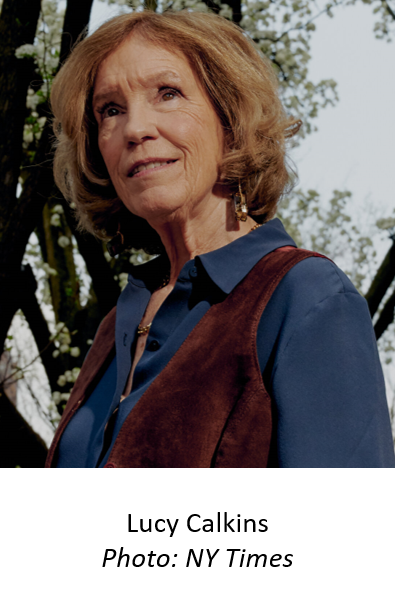The Immutable Truth About Phonics
Once in a blue moon, a liberal/progressive educational pillar collapses, prompting celebrations by those who have labored for decades to topple it. But as this article will demonstrate, progressive willingness to admit defeat only goes so far.
To illustrate is the case of education professor and author Lucy Calkins, who was for decades a champion of so-called "balanced literacy" in reading — which essentially means word guessing — and whose flawed programs flourished in schools nationwide, leaving many a student unable to read. Calkins was recently featured in a New York Times article as having changed her tune and embraced phonics.
Calkins is certified in the teaching of reading, and is founding director of the Teachers College Reading and Writing Project at Columbia University. Now 70, her philosophy has been that children are "natural readers" and that they should be given a "voice" in how they learn; that they should be encouraged to "discover and refine their own writing style" as they compose their own stories and journals. Her curriculum, called "Units of Study," is built on this premise and was not only "wildly popular," according to the Times, but also very profitable, with one-fourth of the nation's 67,000 elementary schools using it.
Additionally, Calkins' organization, the Teachers College Reading and Writing Project, is billed as a "not-for-profit think tank." But the Times contends it is a money-making business venture as well, which includes a stable of highly compensated consultants, books schools pay for that accompany Calkins' curriculum, and other revenue-producing activities.
'Science' chooses phonics
Regardless of the popularity and reach of the purveyor, when a reading program fails to teach children to read, it's difficult to expect them to learn to write, and the gap inevitably becomes noticeable. Given the increasing impact of "science" on every endeavor in recent decades, and especially since the start of the pandemic, it was perhaps inevitable that the "science of reading" would amass data unmasking the failure of Calkins' and other look-say reading methods.
 As the Times observed: "With brain science steadily adding to that evidence, there is a sense — at least for many in the education establishment — that the debate over early reading instruction may be ebbing. Phonics is ascendant."
As the Times observed: "With brain science steadily adding to that evidence, there is a sense — at least for many in the education establishment — that the debate over early reading instruction may be ebbing. Phonics is ascendant."
Perhaps if one of the greatest champions of phonics instruction, Phyllis Schlafly, were alive today, she would find some satisfaction in this acknowledgement of what she knew to be true for most of her long life; that phonics is the means whereby children of all socio-economic groups, ethnicities, and backgrounds can best learn to read.
Phyllis not only created her own proven phonics programs, First Reader and Turbo Reader, but she championed other supporters of phonics over the years and mentioned them in her writings. For example, she lauded the Virginia-based National Right to Read Foundation (NRRF) which was active in promoting phonics instruction programs for more than 20 years. (The organization has recently closed its website.)
In July 2000, Education Reporter described a study by the National Reading Panel (NRP) showing that, "to be effective, reading instruction must include phonics." The study was billed as "the largest, most comprehensive evidence-based review ever conducted of research on how children learn reading." Its conclusions were that children should be taught "phonemic awareness, phonics, and fluency, or how to read orally with speed, accuracy, and proper expression." Finally, this study emphasized the necessity of children being taught strategies for how to comprehend what they read.
Mrs. Schlafly almost certainly would not have praised the "balanced literacy" philosophy of Professor Calkins. While Calkins now claims she never doubted "the importance of phonics," for decades she placed little importance on it. The Times notes that, in her influential 2001 book, The Art of Teaching Reading, Calkins "warned about what she saw as the risks of 'too much sounding-it-out.' She praised one teacher for avoiding 'an intricate series of activities with phonics,' and argued that a simple way to build 'lifelong readers' was to allow children to spend time with books they chose, regardless of content or difficulty." A logical question is how useful spending time with a book would be for a child who cannot read it.
During most of her career Professor Calkins "said little about sounding-out and recommended a word-guessing method, sometimes called three-cueing. According to the Times, "this practice is one of the most controversial legacies of balanced literacy. It directs children's attention away from the only reliable source of information for reading a word: letters.
"Three-cueing is embedded in schools. Thousands of how-to guides are available online, and a 2020 video shows a teacher telling children "to use a picture to guess the word 'car,' even though simple phonics make it decodable."
Is Calkins' about-face real?
 The New York Times says Calkins changed her mind about the science of reading in response to several experts who criticized her work, including journalist Emily Hanford. In October 2020 Hanford wrote: "The United States has long struggled with teaching kids to read; 65 percent of fourth graders read at a level considered basic or below, according to the most recent National Assessment of Educational Progress (NAEP).
The New York Times says Calkins changed her mind about the science of reading in response to several experts who criticized her work, including journalist Emily Hanford. In October 2020 Hanford wrote: "The United States has long struggled with teaching kids to read; 65 percent of fourth graders read at a level considered basic or below, according to the most recent National Assessment of Educational Progress (NAEP).
"Reading scientists say part of the problem is that popular curriculum materials, including those written by Calkins, rely on a disproven theory about how people read. That theory says people use meaning and sentence structure to predict words as they read when, in fact, decades of cognitive science research show that skilled reading requires an ability to decode, matching the sounds in words with the letters used to spell them."
But Calkins was not the only promoter of cueing. Hanford wrote in 2019 that cueing was "a disproven theory" that remained part of American education, causing many kids to continue to struggle with learning how to read.
"The theory was first proposed in 1967, when an education professor named Ken Goodman presented a paper at the annual meeting of the American Educational Research Association in New York City," Hanford wrote. "In the paper, Goodman rejected the idea that reading is a precise process that involves exact or detailed perception of letters or words. Instead, he argued that as people read, they make predictions about the words on the page using these three cues:
- graphic cues (what do the letters tell you about what the word might be?)
- syntactic cues (what kind of word could it be, for example, a noun or a verb?)
- semantic cues (what word would make sense here, based on the context?)"
Goodman's conclusion: "Skill in reading involves not greater precision, but more accurate first guesses based on better sampling techniques, greater control over language structure, broadened experiences and increased conceptual development. As the child develops reading skill and speed, he uses increasingly fewer graphic cues.
"Goodman's proposal became the theoretical basis for a new approach to teaching reading that would soon take hold in American schools." Calkins later incorporated it as part of her reading method.
Regarding Calkins' purported about-face on teaching phonics, the Times wrote that despite her assertion that "word-guessing would not be included in her revised curriculum," she is peddling "a hybrid of her old and new methods." She recommends that "students should first decode words using 'slider power' — running their fingers under letters and sounding them out — but then check for mistakes using 'picture power.'" Mark Seidenberg, a cognitive neuroscientist at the University of Wisconsin, Madison, said that while he found some of the revisions 'encouraging,' he was concerned that 'objectionable' concepts remain.
Some parents, whose children have failed after being taught to read using Calkins' methods, said "no revision from Professor Calkins could earn their trust." One mom of three dyslexic students told the Times: "When children don't learn to read, they doubt their ability to do anything in life."
Want to be notified of new
Education Reporter content?
Your information will NOT be sold or shared and will ONLY be used to notify you of new content.
Click Here
Return to Home Page
